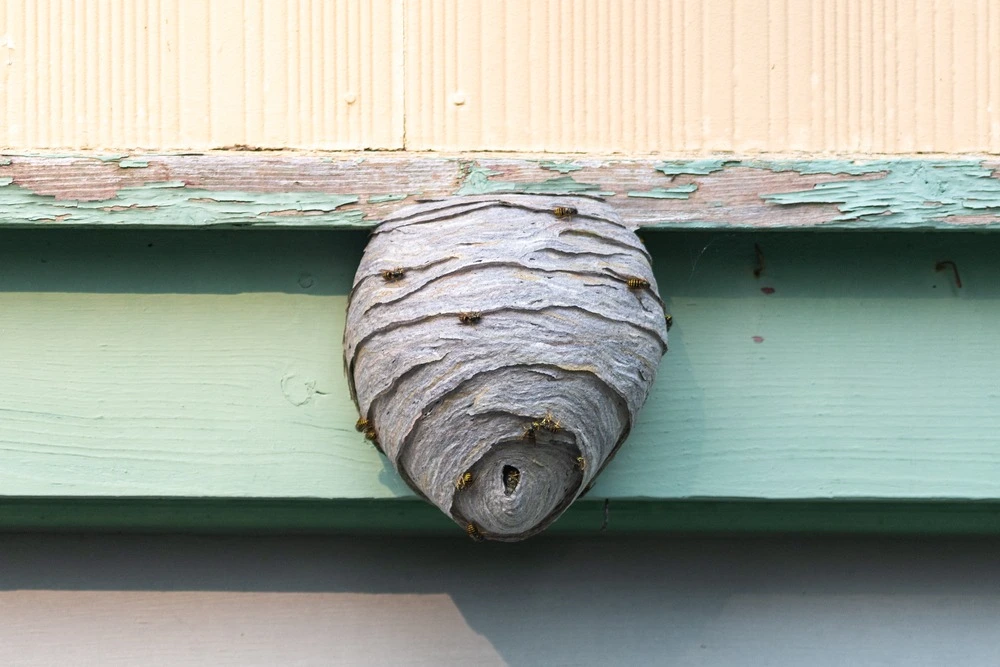
Mosquito Joe explains how to identify a wasp nest and what to do if you find one.
|
Picture this: You’re enjoying a lazy afternoon in your backyard, drink in hand, when you spot a strange, papery blob dangling from your eaves. Your first thought? “Hmm, what’s that?” Your second thought? “What would happen if I poke it?” (Spoiler: You definitely should not poke it.)
But hey, you’re here now, which means you made the right choice by looking it up before things got really interesting. In this guide, we’ll answer the question, “What does a wasp nest look like?” We’ll also break down how to identify different types of wasp nests, where to find them, and what to do if you stumble upon one. (In case you’re wondering what a wasp looks like, we can help with that too!
Types of Wasp Nests and How to Identify Them
Have you been staring at that strange object near the roof and wondering, “What does a wasp hive look like, anyway?” You’re not alone! In fact, the answer isn’t as simple as it sounds. Different wasps build different types of nests, and knowing which kind you’re dealing with can help you determine the best course of action. Let’s explore the key factors in wasp nest identification and the types of wasps responsible for them.
Paper Wasp Nests: Nature’s Open-Concept Design
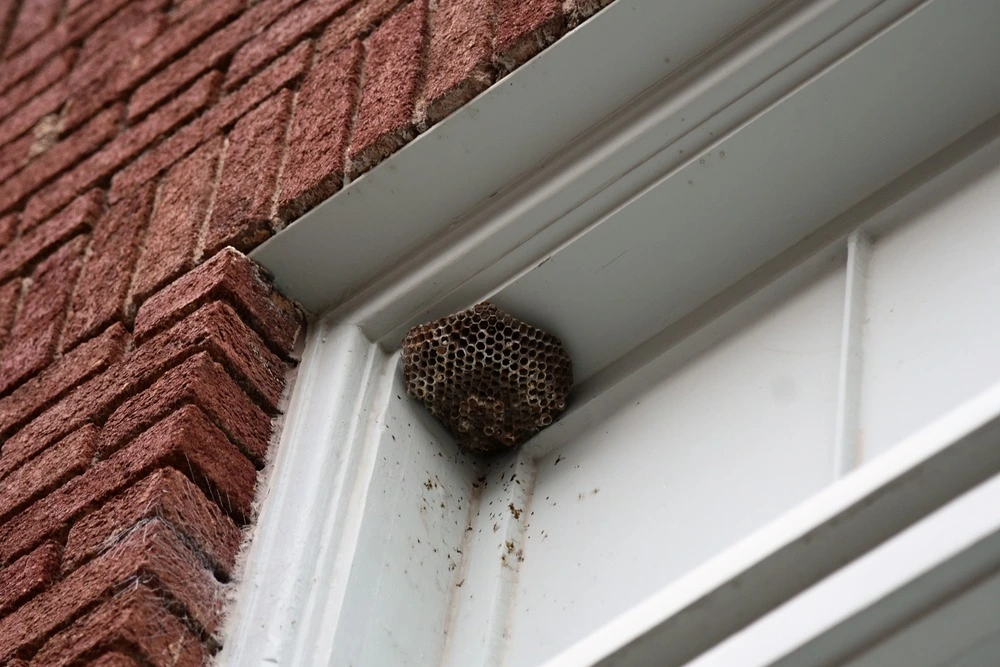
Paper wasps have slender bodies (about ¾ to 1 inch long) and black, brown, or reddish coloring, often accented with yellow markings. Their nests are small, open, and usually built in protected spaces above the ground.
-
Nest Appearance: Resembling an upside-down umbrella, paper wasp nests have exposed hexagonal cells that give them a honeycomb-like structure.
-
Material: Made from chewed wood fibers mixed with saliva, creating a papery pulp with a lightweight texture.
-
Location: Paper wasp nests are often found hanging from porch ceilings, under eaves, or attached to tree branches.
-
Where they live: Found nationwide, but most common in warmer climates like the Southeast and Southwest.
Paper Wasp Identification Tip: Unlike other wasps, paper wasps are considered non-aggressive unless faced with a threat to themselves or their nest. They’re the only type of wasp whose legs are generally visible hanging down during flight.
Paper Wasp Nests: Nature’s Open-Concept Design
Yellowjacket Nests: The Hidden Sting Operation
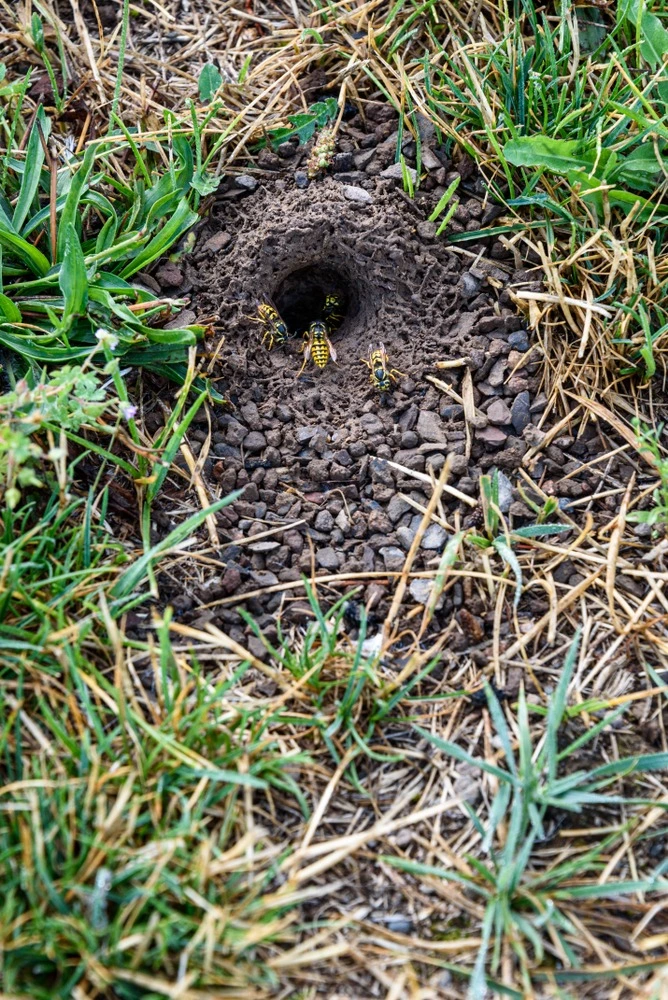
Yellowjackets are compact, aggressive, and sport bright yellow-and-black-striped bodies that are often mistaken for bees—but yellowjackets are all buzz and no fuzz! They’re smaller than paper wasps, around ½ inch long, with a smooth body and defined waist. Think of yellowjackets as the ornery cousins of the wasp family: They don’t back down from a threat and are quick to make their presence known.
- Nest Appearance: Large, enclosed nests with a smooth, grey, papery outer shell that hides the internal cells.
- Material: Yellowjacket nests consist of a light, papery material, but with a more fortified, compact structure than paper wasp nests.
- Location: While some yellowjacket breeds build aerial nests that you might spot beneath your eaves or among tree branches, yellowjackets typically hide their nests underground or inside wall voids, attics, and crawl spaces.
- Where They Live: Yellowjackets thrive in temperate climates and are highly active in the Midwest, Northeast, and Southern states.
Yellowjacket Identification Tip: Yellowjackets are known for their aggressive behavior, especially in late summer when their colonies are at full capacity. If you can’t tell whether you’re looking at a yellowjacket, keep your distance and watch for a characteristic side-to-side flying motion as they land.
Yellowjacket Nests: The Hidden Sting Operation
Hornet Nests: The Football Fanatics
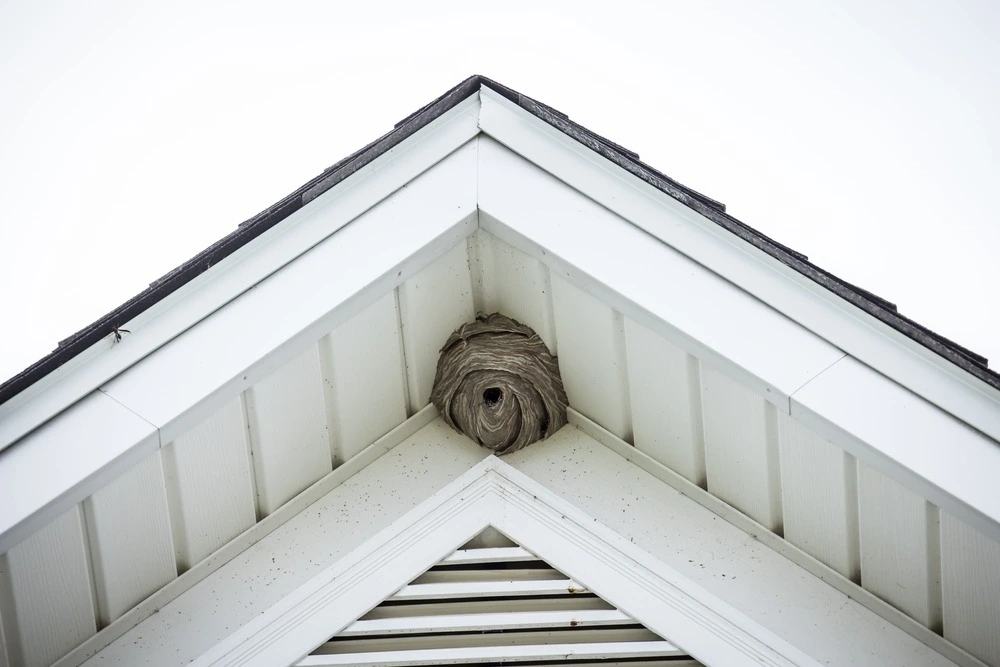
Hornets are large, menacing-looking wasps with dark bodies and bright orange or yellow markings. They can grow up to 1½ inch long and are known for their swift, aggressive nature.
- Nest Appearance: Hornet nests are very large and bulbous, sometimes resembling a football. They are enclosed with a gray, papery exterior and an entrance near the bottom.
- Material: Hornets craft their nests from chewed wood pulp that gives the nest a distinct papery texture.
- Location: Look for hornet nests in trees, shrubs, and near the corners of buildings. Hornets also make nests from abandoned bee hives!
- Where They Live: Primarily found in forested areas across the U.S., with hotspots in the Southeast, Midwest, and Northeast.
Hornet Identification Tip: Hornets are the masters of building large, aerial nests that match their large size. They may not be as aggressive as yellowjackets, but hornets will vigorously defend their nests and may become aggressive around food sources like sweet fruits and other insects.
Hornet Nests: The Football Fanatics
What Does the Start of a Wasp Nest Look Like?

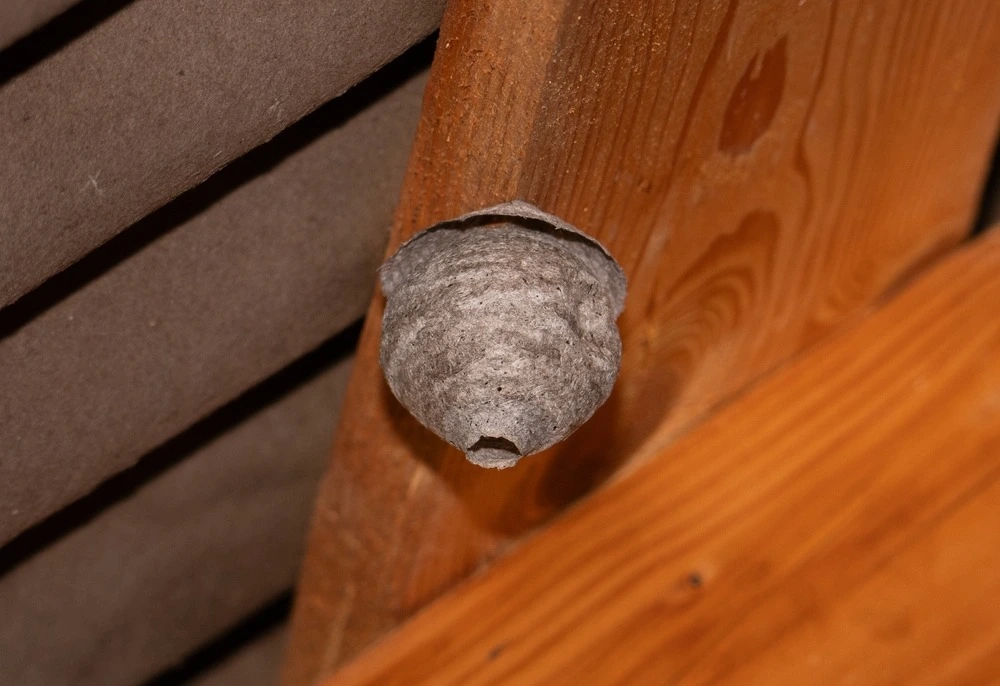
A wasp nest doesn’t appear overnight. It starts small, usually the size of a marble or golf ball, with just a few hexagonal cells built by the queen. In these early stages, the nest may not seem like much of a concern, but don’t let its small size fool you. As the colony grows, the workers rapidly expand the nest, adding new layers and chambers to accommodate their growing population.
Early Detection Tip: If you spot a small, budding nest early in the season (typically in spring), call a professional for removal before it becomes a larger, more aggressive colony.
What Does an Active Wasp Nest Look Like?
Identifying a wasp nest that’s still in use is simple: An active wasp nest will be buzzing—literally—with signs of life. Watching for these signs can help you recognize an active colony and call for professional assistance:
- Wasp Activity: A steady flow of wasps flying around your property is a strong indicator of an active colony nearby.
- Buzzing Sounds: You may hear a consistent buzzing noise coming from walls, trees, sheds, or shrubs as the colony works tirelessly inside.
- Hive Expansion: Over time, nests grow larger as the population grows. Increased wasp presence indicates a thriving colony.
Safety Reminder: Disturbing an active wasp nest can lead to defensive swarming and multiple stings. Always leave nest removal to the pros.
Where Are Most Wasp Nests Located?
Wasps choose their nesting locations carefully, looking for spots that offer shelter and protection. While different species prefer different environments, here’s where you’re most likely to find a wasp nest:
- Under eaves, porch ceilings, and deck railings
- Inside wall voids, attics, and crawl spaces
- Underground in abandoned rodent burrows or soil cavities
- On tree branches, shrubs, and fence posts
Prevention Tip: Have regular pest inspections of these areas during peak wasp season (late spring through early fall) to catch any new nests before they grow out of control.
Wasps love prime real estate with a view—just not one you want to share!
Let Mosquito Joe Handle Your Wasp Woes!
If you’ve spotted a wasp nest and want to avoid a sting operation, leave it to the pros at Mosquito Joe®. Our service professionals have the expertise to provide quick, effective wasp nest removal. Contact your local Mosquito Joe today to learn how we can make outside fun again for you and your family.
Why Call Mosquito Joe? Our service professionals know how to identify the type of wasp nest, assess its activity level, and remove it without a hassle—saving you from painful stings and potential damage to your property. Plus, all work is backed by the Neighborly Done Right Promise® and the Mosquito Joe Satisfaction Guarantee to ensure you’ll be happy with our work.
This article is intended for general guidance only and may not be applicable to every situation. You are responsible for determining the proper course of action for your property and your situation. Mosquito Joe is not responsible for any damages that occur as a result of any advice or guidance derived from blog content. For the most accurate guidance, contact an independently owned and operated Mosquito Joe for more information and a professional on-site assessment.
FAQs About Wasp Nest Identification
Since 2010, Mosquito Joe professionals have protected families like yours from nasty biters that would have you itching and scratching your way through summer. As an industry leader dedicated to environmentally sound pest control, we’re happy to use our many years of experience to answer your most frequently asked questions about wasp nest removal or wasp identification.
How can I tell if a wasp nest is abandoned?
A wasp nest that’s been abandoned shows zero signs of life—no wasps coming or going, no buzzing, no aerial acrobatics. But you shouldn’t let your guard down just yet. Some species, like paper wasps, occasionally reuse old nests, so it’s always best to have a service professional confirm whether it’s truly abandoned.
Pro Tip: If you’re unsure, leave the nest alone and let the experts at Mosquito Joe handle it. Don’t suffer empty nest syndrome alone!
What’s the difference between a wasp nest and a beehive?
Unlike beehives, wasp nests are made from a papery pulp that looks like recycled newspaper, and are often found hanging from eaves or trees or built in concealed areas underground. Beehives, on the other hand, are crafted from wax and house busy bees producing honey.
Identification Tip: If it looks like a DIY paper-mache project gone wrong and isn’t dripping with honey, you’re likely looking at a wasp nest. However, both beehives and wasp nests should be considered potential safety hazards. Consult a professional for identification and removal.
Are wasp nests dangerous?
Absolutely. Active wasp nests are not something you want to mess with. Wasps are fiercely territorial and can sting multiple times when they feel threatened. Disturbing a nest—even by accident—can turn a quiet afternoon into a real-life action scene. If you’re dealing with an active nest, keep your distance and call in the pros.
Safety Reminder: Don’t risk DIY removal of a wasp nest. Trust a professional wasp nest removal service like Mosquito Joe.
Related Topic: The Dangers of DIY Wasp Nest Removal
How do I identify a wasp nest early?
Early-stage wasp nests often look like tiny paper cones, no bigger than a golf ball, with a few hexagonal cells visible. These starter nests are usually built under eaves, porch roofs, or tree branches. Spotting a nest at this stage gives you a head start on prevention before the colony grows.
Quick Tip: If you see a small, papery structure starting to form, take action early by calling Mosquito Joe to stop a full-blown wasp invasion.
Can I prevent wasps from building nests around my home?
Yes! Prevention is key. Wasps love sheltered spots, like under eaves, porch roofs, and tree branches. To discourage them, regularly check these areas and seal any cracks or crevices where they might sneak into unwatched spaces. Using outdoor insect repellents around high-risk areas can also help deter shelter-seeking wasps.
Pro Move: Schedule seasonal treatments with Mosquito Joe to keep wasps (and other pests) from setting up shop in your yard.
Do wasps reuse the same nest every year?
Most wasp species abandon their nests at the end of the season, but some, like paper wasps, might reuse old nests. However, it’s not a guarantee. A new queen typically likes a fresh start and will begin building her own nest in the spring.
Wasp Prevention Tip: Even if a nest looks empty in winter, it’s best to have it removed before spring to avoid any unexpected surprises when the weather warms up.
Want more tips and insights? Check out our blog for expert advice on keeping your yard swat-free!
